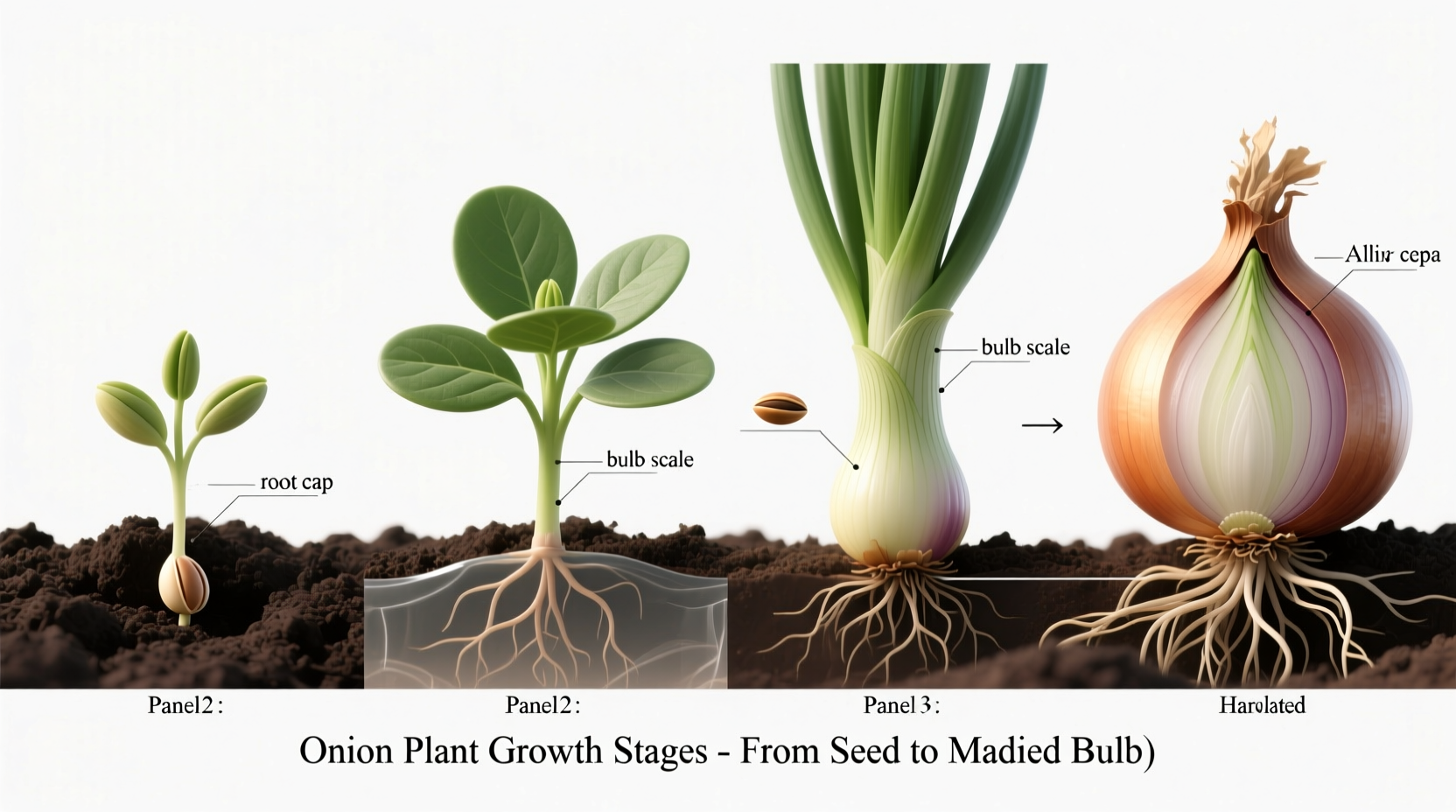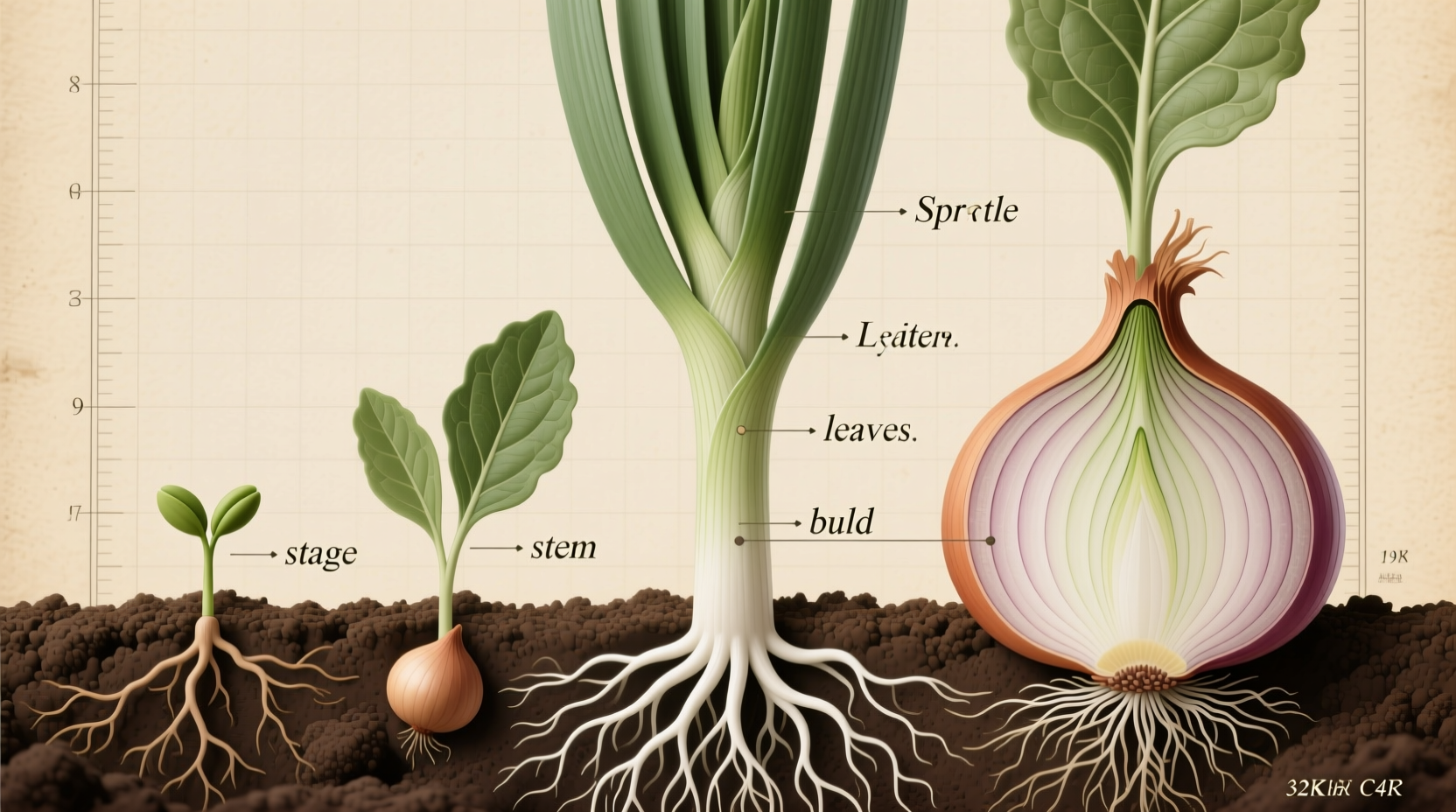Discover exactly how onion plants develop from tiny seeds to full-sized bulbs with this comprehensive guide. Whether you're planning your first garden or refining your onion-growing skills, you'll learn the precise conditions, timeline, and techniques that lead to successful harvests—plus avoid common mistakes that ruin yields.
Understanding the Onion Growth Timeline
Onions follow a predictable growth pattern that responds to environmental cues. Unlike many vegetables, their development is heavily influenced by day length, which determines when bulb formation begins. This biological process, called photoperiodism, is why selecting the right variety for your region is critical.
| Growth Stage | Duration | Key Development | Visible Indicators |
|---|---|---|---|
| Germination | 7-14 days | Root and shoot emergence | Green shoots appear above soil |
| Leaf Development | 4-8 weeks | Photosynthetic growth | 3-12 green leaves forming |
| Bulb Initiation | Triggered by day length | Storage tissue formation | Base begins swelling |
| Bulb Maturation | 4-6 weeks | Layer development | Bulb reaches full size |
| Maturity | 2-3 weeks | Natural senescence | Leaves fall over, neck dries |
This growth timeline comes from research conducted by the Oregon State University Extension Service, which has documented onion development patterns across multiple growing seasons. Their studies confirm that day length is the primary environmental factor determining when bulb formation begins, with short-day varieties requiring 10-12 hours of daylight and long-day varieties needing 14-16 hours.
Essential Conditions for Successful Onion Growth
Onions thrive under specific conditions that support their unique growth requirements. Getting these elements right makes the difference between small, underdeveloped bulbs and robust, flavorful onions.
Soil Requirements
Onions prefer loose, well-drained soil with a pH between 6.0 and 6.8. Heavy clay soils restrict bulb development, while sandy soils drain too quickly. The USDA National Agricultural Library recommends incorporating 2-4 inches of compost to improve soil structure and fertility before planting. Avoid fresh manure, which can cause misshapen bulbs and increase disease risk.
Temperature Considerations
Onion seeds germinate best at soil temperatures between 68-77°F (20-25°C). Once established, plants tolerate temperatures as low as 28°F (-2°C) but growth slows significantly below 50°F (10°C). The critical temperature range for bulb formation is 60-75°F (15-24°C) - temperatures outside this range can cause premature bolting or poor bulb development.
Water Management
Consistent moisture is crucial throughout the growing season, with about 1 inch of water per week. During bulb formation, reduce watering to prevent rot, then stop completely 2-3 weeks before harvest to allow proper curing. Inconsistent watering causes splitting and increases disease susceptibility.

Step-by-Step Onion Growing Process
Planting Methods Compared
You can grow onions from seeds, sets (small bulbs), or transplants, each with distinct advantages:
- Seeds: Most economical option, offers greatest variety selection, but requires 8-10 weeks of indoor growing before transplanting
- Sets: Easiest method for beginners, faster harvest, but limited variety options and higher risk of bolting
- Transplants: Balance of ease and variety, available commercially, ready for immediate planting
Planting Depth and Spacing Guidelines
Plant seeds ¼ inch deep, thinning to 4-6 inches apart when seedlings reach 4 inches tall. Sets should be planted with the pointed end up, just below the soil surface, spaced 4-6 inches apart. Proper spacing ensures adequate room for bulb expansion without competition for nutrients.
Critical Growth Phase: Bulb Formation
The transformation from leafy top to bulb happens when onions reach their specific day-length requirement. During this phase, the plant redirects energy from leaf production to bulb development. You'll notice the base of the plant beginning to swell as leaf bases transform into storage tissue. This process takes 4-6 weeks, during which consistent moisture and adequate nutrients are essential for maximum bulb size.
Troubleshooting Common Onion Growing Problems
Why Onions Fail to Form Bulbs
If your onions produce healthy tops but no bulbs, you've likely planted the wrong variety for your region's day length. Short-day varieties (10-12 hours) work best in southern regions, while long-day varieties (14-16 hours) suit northern climates. Day-neutral varieties offer flexibility for intermediate zones.
Managing Pests and Diseases
Thrips are the most common pest, causing silvery streaks on leaves. The University of Minnesota Extension recommends insecticidal soap applications at the first sign of damage. For fungal diseases like pink root, rotate crops and ensure proper soil drainage. Never plant onions in the same spot more than once every 3-4 years.
Harvesting and Curing Onions Properly
Harvest onions when about half the tops have naturally fallen over. Gently lift bulbs from the soil and allow them to cure in a warm, dry, well-ventilated area for 2-3 weeks. During curing, the outer layers dry and form protective skins while the neck seals completely. Properly cured onions can store for 6-8 months in cool, dry conditions.
Maximizing Your Onion Harvest
For the best results, follow these professional tips:
- Apply nitrogen fertilizer during leaf development, then switch to phosphorus and potassium during bulb formation
- Weed carefully to avoid damaging shallow roots
- Stop watering 2-3 weeks before harvest to improve storage quality
- Choose varieties specifically bred for your climate zone
- Test soil before planting to ensure proper pH and nutrient levels











 浙公网安备
33010002000092号
浙公网安备
33010002000092号 浙B2-20120091-4
浙B2-20120091-4